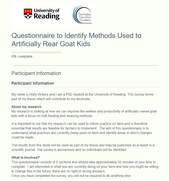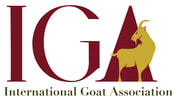 The recent meeting in Edinburgh (26-28 November) had a specific session organised with the stakeholders to develop a primary contact with them, introduce their Organisations to the WP Partners and collect their first views beneficial to the management of the project. Such meeting has been the best opportunity to foster positive associations and interactions for the creation of a network able of keeping a uniqueness of the project but also to approaching innovation through a multi-expertise vision. The variety in the composition and in the field of actions of the stakeholders would have had a potential negative consequence on the project due to a lack of unique vision but such risk was deactivated by a shared approach and the awareness of having common interests and the recognition of being part of a single team.
0 Comments
 My name is Holly Vickery, and I am a PhD student at the University of Reading, United Kingdom. There is currently very little information on management systems for goats worldwide, and even less which focuses explicitly on the husbandry of kids that are reared artificially (away from their mothers). My research is looking at how we can improve the welfare and productivity of artificially reared goat kids with a focus on milk feeding and weaning methods. It is important to me that my research can be used to inform practice on-farm and is therefore essential that results are feasible for farmers to implement. This questionnaire aims to understand what practices are currently used on-farm and identify areas in which changes could be made. There is no geographical limit on this survey, so wherever you are – if you’re artificially rearing goat kids, you are able to participate! The survey should only take about 10 minutes of your time to complete. Please participate in my survey if you’re able to https://reading.onlinesurveys.ac.uk/questionnaire-to-identify-methods-used-to-artificially-rea Thank you, Holly Vickery [email protected] The Annual Dairy Sheep and Goat Conference has world class lectures on aspects of Dairy Sheep and Dairy Goat production and medicine, aimed at all small ruminant farmers, vets, advisors, nutritionists and suppliers. A combination of quality science and practical information given to an audience of farmers and vets.
1. Introduction
In the United Kingdom, the production of goat milk has changed drastically in the last ten years. The industry is continuously looking for significant future developments in areas such as artificial insemination and genomics, disease control, mortality reduction and protocols for rearing kids. Nonetheless, the goat industry is not a notable livestock sector in the United Kingdom, as evidenced by the evolution in the number of animals during the last 25 years (Figure 1). According to FAO census data, the total number of animals was at a maximum in 1990, followed by a continuous decline until the beginning of the 2000s. After that, the number of heads showed an upswing with some peaks and valleys, and a linear increase from 2010 to 2016 (FAOSTAT, 2016). The largest concentrations of commercial goat operations are found in York, Somerset and Worcestershire counties, all of them located in England.  DESCARGAR DESCARGAR Heather Briggs, Representante de la International Goat Associations en Reino Unido INTRODUCCIÓN La producción de leche de cabra ha cambiado drásticamente en los últimos 10 años en el Reino Unido. La actividad está continuamente mirando hacia un desarrollo significativo en áreas como la inseminación artificial y la genómica, el control de enfermedades, la reducción de la mortalidad y los protocolos de crianza de los cabritos. A pesar de ello, el caprino no es un sector ganadero destacable en Reino Unido, si vemos la evolución en el número de cabezas en los últimos 25 años (Figura 1) el censo marca un máximo donde comienzan la serie de datos de la FAO en el año 1990, un descenso continuo hasta inicio de los años 2000, seguido de un aumento constante de las cabezas, sobretodo hasta el año 2008, que el incremento se vuelve más errático y casi estancado (FAOSTAT, 2016). Las concentraciones más grandes de cabras comerciales se encuentran en los condados de York, Somerset y Worcestershire, todos ellos en Inglaterra.  Country Representative for United Kingdom Heather is a mature, part-time, self-funded Ph.D. candidate at the Sustainability Research Institute, University of Leeds. Her interest in goats stems from work done in translations for a number of specialist researchers on the caprine species. She holds an MSc in Agricultural Economics from Wye College, University of London and is a freelance agricultural journalist regularly working for numerous national and international agricultural trade publications. She also has experience as manager of an agricultural cooperative based in Spain and exporting fruit and vegetables to the UK and the Netherlands. Her doctoral research involves investigating links between sustainable intensification and vertical farming. She is also an international cheese judge, judging at the Nantwich International Cheese Awards and the World Cheese Awards. Dairy farmers of the future could be raising male kid goats (billies) for the meat market as a supplementary source of income, according to James Whetlor, co-proprietor of specialist wholesaler Cabrito Goat Meat.
The market for kid-goat meat is on the rise, with a steady but constant increase in demand that is thanks to Mr Whetlor’s innovative trickle-down marketing, who now supplies billies to more than 50 restaurants. “There is a huge, untapped market out there, but first we need to ensure that people can try the meat quite cheaply,” says the former London chef. International Sheep Veterinary Congress Wednesday, May 24 2017 Harrogate, United Kingdom
Foreword:
The Food and Agriculture Organization of the United Nations (FAO) and the World Organization for Animal Health (OIE) have developed a programme to eradicate PPR and the virus that causes it, by 2030. This program is termed the Peste des Petits Ruminants Global Eradication Programme or the PPR-GEP[1]. This workshop was organized by the International Goat Association (IGA) to present multiple perspectives on the benefits and challenges of this massive undertaking. IGA has been the advocate of goat research, production and development to benefit humanity since 1982, and is a member of the PPR-GEP Advisory Council. [1]http://www.oie.int/fileadmin/Home/eng/Media_Center/docs/pdf/PortailPPR/EN_GEP_PPR_Finalweb.pdf Summary from the Presenters The participants congratulate FAO, OIE and other partners for the 2030 vision of global freedom of Peste des Petits Ruminants. Eradication will improve small ruminant production that can contribute to gender empowerment, food security, poverty alleviation and resilience as well as biodiversity conservation, if done correctly. We request each ISVC participant to advocate for this vision to donors and decision makers to financially support the implementation of PPR Global Eradication Programme. PPR is the third viral disease targeted for global eradiation, after smallpox in humans, and rinderpest in cattle. The selection of PPR indicates the importance of small ruminants for human livelihoods and nutrition, and environmental impacts, and presents an opportunity for us to expand public knowledge and attitudes about sheep and goats for the future. Written by Heather Briggs, IGA Country Representative, United Kingdom
The sweet, salty and nutty flavor of the blue goats’ cheese presented by the Cornish Cheese Company resulted in it winning the category ‘100 percent Goat Milk Cheese open to UK Producers’ at the 2017 International Cheese Awards held at Nantwich, the United Kingdom on July 25. Kay Barlow, Category Technical Manager for Core Chilled at British supermarket chain ASDA, judged the class alongside Heather Briggs, who is also the International Goat Association’s UK country representative. Both had no hesitation in declaring their winner. |
IGA Blog
The International Goat Association promotes goat research and development for the benefit of humankind, to alleviate poverty, to promote prosperity and to improve the quality of life. Archives
May 2024
Categories
All
|
|
International Goat Association
2516 Millbrook Rd., Little Rock, AR72227 USA email: [email protected] -454-1641 |


 RSS Feed
RSS Feed